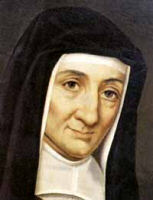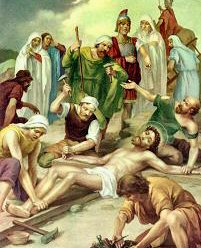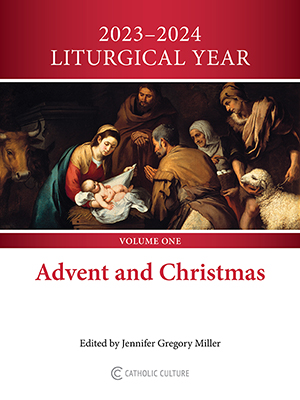Lent: March 15th
Wednesday of the Third Week of Lent
Other Commemorations: St. Louise de Marillac, Widow (RM)
» Enjoy our Liturgical Seasons series of e-books!
Today we have a venerable Lenten Mass. This Mass is best understood by remembering that the ancient catechumens (or prospective converts) used to come for instructions to the first part of Lenten Masses. The catechumens heard the readings and homily, and then left the church. The offertory procession and remainder of the Mass were for the faithful. This Wednesday was the first “scrutiny,” or test, for the catechumens. That test was on the Commandments of God. Both readings, consequently, are about the Commandments. —The Vatican II Weekday Missal
Today the Roman Martyrology commemorates St. Louise de Marillac (1591-1660). She was born in 1592, and married in 1613. When her husband died she made a vow of widowhood and devoted herself entirely to works of charity. St. Vincent de Paul, who became her spiritual director, gradually initiated her into his own charitable works for the poor and afflicted, and in 1639 they founded the Congregation of the Daughters of Charity to which St. Louise dedicated the rest of her life. She was canonized by Pope Pius XI on March 11, 1934.
Meditation—Obedient Unto Death
This we have frequently heard and have often meditated upon — but have we conformed our lives to this model so worthy of imitation? Must we not confess that we strive often to appear superior in our natural and spiritual talents? Do we not all too frequently boast of our accomplishment as if no one had ever equalled us? Does not history show how man in his pride has exceeded al bounds, seeking to place himself on a level with — and at times even above — Almighty God?
Yet Christ, Who was true God, "emptied Himself, taking the nature of a slave and being made like unto men, and appearing in the form of man, He humbled Himself, becoming obedient to death, even to the death of the Cross" (Phil. 2:7). It is precisely in this deep humiliation that He wishes to continue dwelling among us. Every Crucifix tells us this: "Learn of Me, for I am meek and humble of heart…I have been obedient unto death. . . I am full of love and patience."
Most of us will go to any lengths to cancel our degradation from our fellow men, while trying to give others the most favorable possible impression of ourselves. King Agesilaus of Sparta was a most excellent ruler, celebrated for his justice and wisdom, but he was most unattractive physically. At his death, he strictly forbade any portrait to be made of himself, whether painted or sculptured. The king feared lest such a visible remembrance of him might lessen the love and esteems which he had gained among his people during his lifetime because of his just and wise rule.
But the Son of God did not fear to approach us in His deepest humiliation and ignominy. He displays Himself to us in all His woe, summoning us to contemplate Him as the Man of Sorrows, asking that we grow in humility and patience by studying His own resignation to the Will of His Heavenly Father. In the gripping words of the prophet Isaias: "There is no beauty in him, nor comeliness; and we have seen him, and there was no sightliness that we should be desirous of him: Despised, and the most abject of men, a man of sorrows, and acquainted with infirmity; and his look was as it were hidden and despised, whereupon we esteemed him not" (Is. 63:2-4).
By means of these liturgical texts, let us penetrate the portrait of our sorrowful Redeemer, learning from Him all the virtues necessary that, in St. Paul's words, "Christ may be formed in us" (Gal. 4:19). This portrait of the patient, loving crucified Savior, Who out of deference to the Will of His Heavenly Father freely went forth to death for us, must stand out vividly before our souls' eyes before we can really conform our life, sacrifice, sufferings and death to His. Then "from glory to glory" His portrait will gradually take form in us in transcending beauty, and having suffered with Christ, we shall, according to God's own promise, "participate in His resurrection."
What better prayer during Lent could rise form the depths of our hearts than that of St. Gertrude, kneeling before her Crucifix: "Accept, O compassionate Jesus, this my prayer with that exceeding love wherewith Thou didst endure a bitter death and didst offer it, together with all the fruit of Thy most sacred Humanity, to God the Father on the day of Thine Ascension; and by the depth of those wounds which scarred Thy Flesh and pierced Thy Hands and Feet and Heart, I beseech Thee, raise me up, who am steeped and sunk in sin, and render me well pleasing to Thee in all things."
—Bernard Strasser, The Dews of Tabor
St. Louise de Marillac
 St. Louise de Marrillac married an official of the royal court, Antony Le Gras, and after his death in 1625 was an active supporter of the charitable work of St Vincent de Paul, who came to put more and more reliance on her. Mademoiselle Le Gras, as she was known, became the co-founder with him of the Daughters of Charity, whose 'convent is the sick-room, their chapel the parish church, their cloister the city streets'; it was she who drew up the first draft of their rule of life. Her clear intelligence and wide sympathy played a big part in the beginnings of the congregation, whose aspirants she trained and whose rapid growth involved responsibilities which largely fell on her. At the time of her death there were already over forty houses of the sisters in France, the sick poor were looked after at home in twenty-six Parisian parishes, hundreds of women were given shelter, and there were other undertakings as well. St Louise was not physically robust, but she had great powers of endurance, and her selfless devotion was a source of incalculable help and encouragement to Monsieur Vincent.
St. Louise de Marrillac married an official of the royal court, Antony Le Gras, and after his death in 1625 was an active supporter of the charitable work of St Vincent de Paul, who came to put more and more reliance on her. Mademoiselle Le Gras, as she was known, became the co-founder with him of the Daughters of Charity, whose 'convent is the sick-room, their chapel the parish church, their cloister the city streets'; it was she who drew up the first draft of their rule of life. Her clear intelligence and wide sympathy played a big part in the beginnings of the congregation, whose aspirants she trained and whose rapid growth involved responsibilities which largely fell on her. At the time of her death there were already over forty houses of the sisters in France, the sick poor were looked after at home in twenty-six Parisian parishes, hundreds of women were given shelter, and there were other undertakings as well. St Louise was not physically robust, but she had great powers of endurance, and her selfless devotion was a source of incalculable help and encouragement to Monsieur Vincent.
—Dictionary of Saints by Donald Attwater.
Patronage: disappointing children; loss of parents; people rejected by religious orders; sick people; Christian Social Workers (proclaimed on 12 February 1960 by Pope John XXIII); Vincentian Service Corps; widows
Symbols and Representation: widows' clothing; Saint Louise is depicted wearing the original Vincentian habit of grey wool with a large headdress of white linen (typical of poor women in 17th century Brittany), perhaps with an infant in her arms.
Highlights and Things to Do:
- Read more about St. Louise:
- Teach your children this simple morning aspiration by St. Louise: "Grant me the grace to spend this day without offending You and without failing my neighbor."
- Daughters of Charity of St. Vincent de Paul which she helped found.
- St. Louise's remains are enshrined in the Chapel of the Miraculous Medal in the motherhouse of the Daughters of Charity in Paris. Her body is not incorrupt, but rather the body in the chapel is actually a wax effigy, containing her bones.
- Begin planning a family Passion presentation or play in which all can participate. You may want to plan this for the end of Lent — Spy Wednesday or Holy Thursday would be particularly appropriate days for this.

Friday of the Fourth Week of Lent
Station with Sant'Eusebio all'Esquilino (St. Eusebius in Esquiline):
Ancient church dedicated to St Eusebius of Vercelli, 4th century bishop. The church was financed by St. Eusebius of Bologna, and is first mentioned in 474. This means that it's one of the oldest churches in Rome; it was one of the first parish churches known as the Titulus Eusebi.
For more on Sant'Eusebio all'Esquilino, see:
For further information on the Station Churches, see The Stational Church.








